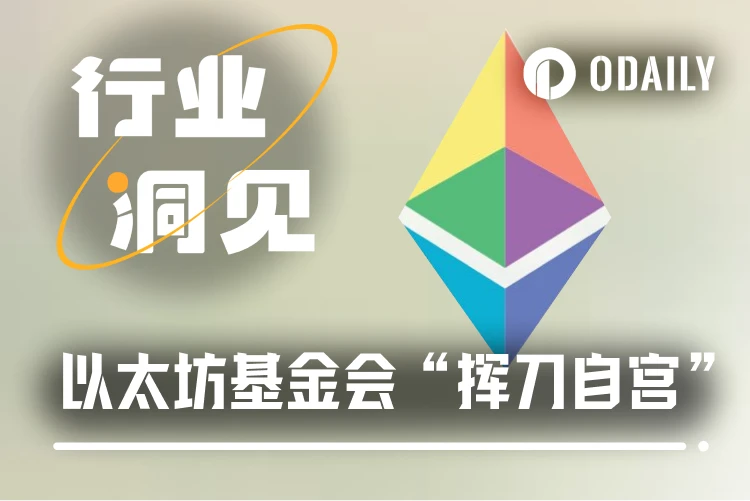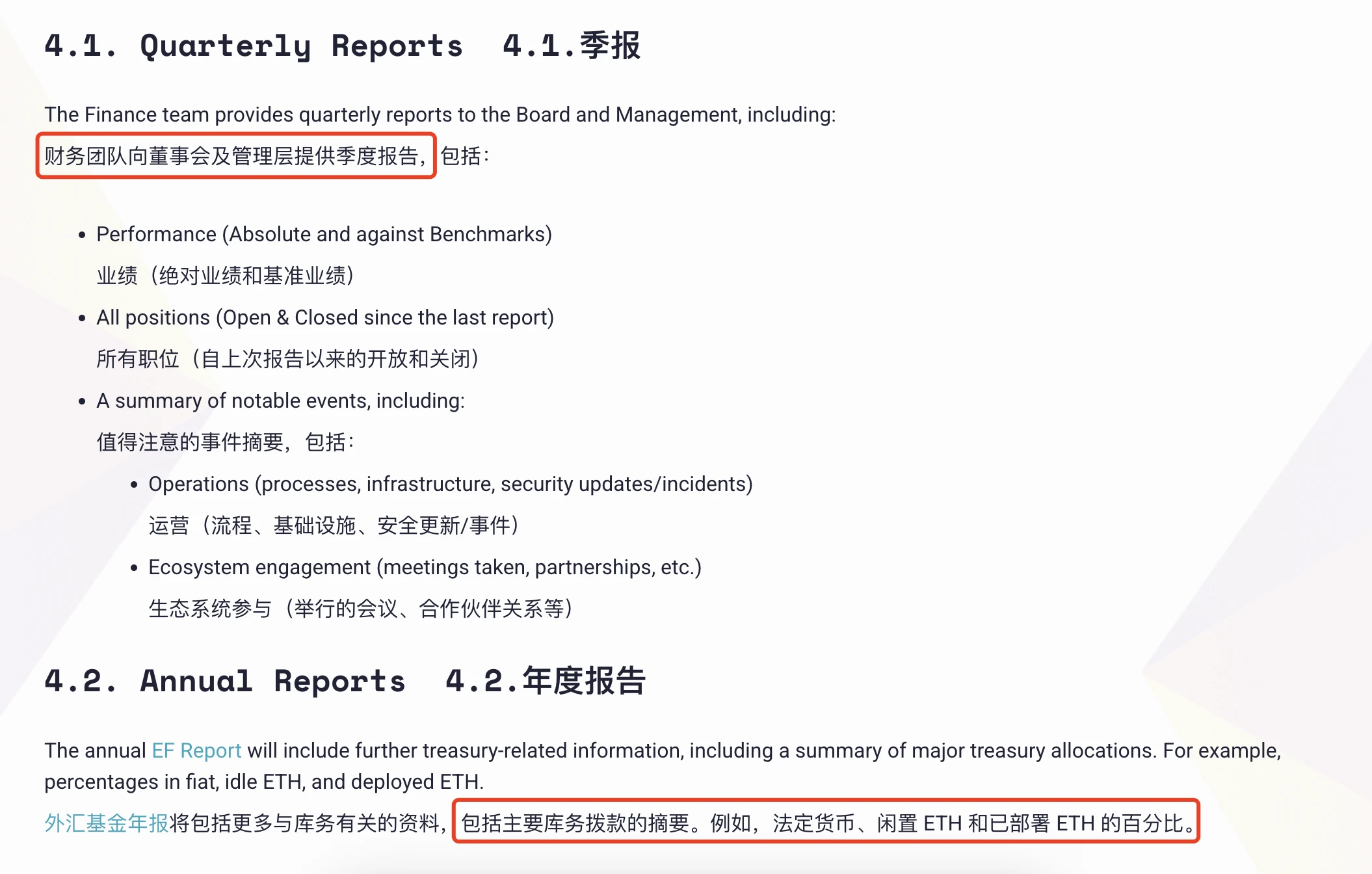Original|Odaily Planet Daily (@OdailyChina)

The reform of the Ethereum Foundation is still ongoing. After Vitalik fired the first shot of "reform", former executive director Aya Miyaguchi stepped back, and new executive director Wang Xiaowei announced subsequent plans in a community interview, the Ethereum Foundation's reform has finally entered the "serious" stage.
On June 3, the Ethereum Foundation published a statement announcing the restructuring of its R&D team and layoffs, focusing on network scalability and user experience; it also launched the Devconnect ARG Scholar Program. Today, the Ethereum Foundation's official account posted again, declaring the foundation's latest financial policy.
It is evident that the Ethereum Foundation is genuinely beginning to shed its arrogance and push for change. Whether the series of plans released can become a booster for ETH prices and a driving force for innovation in the Ethereum ecosystem remains to be seen. Odaily Planet Daily will provide a brief analysis of the recent changes at the Ethereum Foundation (hereinafter referred to as EF) and their subsequent impacts.
EF's Internal Changes: The First Cut Targets the R&D Team
As mentioned in our article “New Officials Bring Three Fires, What Direction Will the New Executive Director of the Ethereum Foundation Take?”:
According to the LinkedIn interface, the number of active members under EF is 281, making it a bona fide medium-sized organization.
Previously, the R&D team was the largest department within EF. Moreover, the R&D team had the following main issues:
The "ambiguous relationship" between EF researchers and projects within the Ethereum ecosystem. The incident involving Ethereum Foundation researchers Justin Drake and Dankrad Feist "restaking themselves" as advisors to the Ethereum restaking project EigenLayer once caused a significant stir within the Ethereum ecosystem. Although both subsequently announced the termination of their collaboration with the project, the incident still somewhat shook the community's trust in EF's internal management and the neutrality of its team members.
The EF R&D team members were stagnant, lacking fresh blood. In September last year, Ethereum core developer Tim Beiko announced that the protocol support team would hire two new employees to handle funding support, marking the first recruitment for that department. If the core department of EF is like this, the rigidity of other R&D teams can be imagined.
The EF R&D team had unclear roles and responsibilities. Undoubtedly, as a medium-sized organization with hundreds of people, EF, which is more loosely structured and emphasizes "decentralized organization," faces significant management challenges. Many people's job responsibilities are unclear, which is partly due to objective limitations, such as the loose nature and decentralized attributes of the crypto community; on the other hand, it is also because the Ethereum protocol has long been in a state of "only the voices of Vitalik and other key figures are considered orthodox" and "immersed in academic research while neglecting real application innovation and market demand."
Based on this, EF's "self-castration" first targets the R&D team, which has the largest number of members and is quite core to the organization. Additionally, the announcement emphasized that EF would restructure the research and development team, renaming it "Protocol" to focus on the core challenges of protocol design. The restructured Protocol team will work on three main priorities: enhancing the scalability of the Ethereum base layer network, advancing blobspace expansion in data availability strategies, and improving user experience. "Some members of the R&D team will no longer continue to stay," and they encourage other teams within the Ethereum ecosystem to absorb these talents. This is somewhat reminiscent of when Jack Ma proudly proclaimed that "Alibaba sends over a thousand outstanding talents to society every year."
Of course, this move does not bring unanimous praise; for example, a pillar figure in the Solana ecosystem, Multicoin Capital co-founder Kyle Samani, commented, "Please note that the definition of 'focus' usually means 'less,' not 'more,' especially when the goals should not conflict with each other. However, when we look at it from the perspective of Goal 3 (i.e., L1 and L2 network expansion, improving user experience), Goal 1 (i.e., layoffs) and Goal 2 (i.e., clarifying responsibilities) are contradictory."
In the future, whether the EF Protocol department can truly carve out a path of protocol innovation in areas such as EIP proposal will depend on their performance.
EF's External Communication: Seeking 100 Devconnect Scholars
Internal reform is one aspect, while external communication is also a top priority for EF at present. After all, with the development of the cryptocurrency industry, the Ethereum ecosystem has gradually become synonymous with "old, rigid, and lacking innovation," simply put, "not as cool as it used to be." In the current accelerated process of crypto mainstreaming, this is undoubtedly very detrimental.
Therefore, EF has to leverage the annual Devcon event to identify "key nodes" for external communication in advance. According to the EF announcement, the scholar program aims to expand Ethereum's influence by connecting Ethereum with new communities, industries, and ideas. 100 scholars will learn and create together, bridging Ethereum with other worlds. The scholars for 2025 will include five categories:
Ethereum community organizers;
Legal and public sector professionals;
Journalists;
Artists;
Developers and other builders.
The application channel can be found here: https://devconnectargscholars.paperform.co/
The application deadline is June 30, lasting nearly a month. It is worth mentioning that this year's Devconnect event will be held in late November in Buenos Aires, Argentina, and the scholar program will start in late August. Of course, applicants must also meet the following conditions:
Have never attended Devcon before,
Have never attended Devconnect before,
Be able and willing to invest about three hours per week in online courses over the three-month program, complete assignments, and actively participate in learning, collaboration, and shared creation.
Undoubtedly, in terms of external communication nodes, EF also urgently needs to supplement fresh blood. Good wine fears no deep alley, especially when the current market price performance of ETH is not so strong.
**EF's Financial Management: Reducing Dumping, Participating in DeFi, Firmly Upholding Defipunk Values
**
Having discussed internal and external reforms, the last question is the one everyone is most concerned about—EF's financial management.
Previously, to maintain organizational operations, EF had to resort to the controversial and criticized action of dumping ETH for fiat currency. In response to this, EF's latest announcement provides solutions mainly divided into three aspects:
EF will comprehensively consider two major factors: annual operating expenses and the number of years of operational expense buffer. Currently, it sets the annual operating expenses at 15% of total finances, retaining a 2.5-year expense buffer, and will gradually transition to a long-term expenditure level of 5% (similar to conventional donation organizations).
EF will prioritize supporting secure, decentralized, and open-source DeFi protocols, obtaining reasonable returns through methods such as wETH staking and stablecoin lending, and exploring Tokenized RWA (tokenized real assets) allocation. Additionally, to further enhance the transparency of asset spending, EF will have its finance team prepare and maintain specific quarterly and annual reports, distributing them based on scope and sensitivity.

EF is finally bidding farewell to messy accounts.
- EF will firmly uphold Defipunk values, actively support Defipunk projects, encourage no KYC, self-custodial, privacy-friendly DeFi protocols, and plans to prioritize privacy standards, decentralized UI, and anti-censorship mechanisms as core evaluation criteria for EF's fund deployment. The announcement emphasized: "Existing systems often impose subtle pressures that narrow the design space for new DeFi primitives and limit privacy-centered innovation. The Ethereum Foundation will resist these pressures." This is also the first time EF has expressed support against censorship mechanisms in an official organizational tone, indicating that ZK technology will still have significant room for development.
Conclusion: ETH Price Discovery Requires More Opportunities
As ETH prices warm up, many bullish viewpoints have recently emerged in the market. The strategy of the US-listed company SharpLink Gaming to stockpile ETH, emulating Strategy's approach to hoarding BTC, has also been seen by many as a prelude to ETH price surges. However, the above events and factors seem more like "short-term remedies" for repairing expectations. The long-term development of the Ethereum ecosystem's trajectory and ETH price performance still depends on EF's various internal and external reforms, which is the true "long-term reassurance."
It can be anticipated that, based on the current planning and advancement pace, the time to verify the correctness of EF's measures will not be short, requiring at least 1-2 years to start.
免责声明:本文章仅代表作者个人观点,不代表本平台的立场和观点。本文章仅供信息分享,不构成对任何人的任何投资建议。用户与作者之间的任何争议,与本平台无关。如网页中刊载的文章或图片涉及侵权,请提供相关的权利证明和身份证明发送邮件到support@aicoin.com,本平台相关工作人员将会进行核查。




